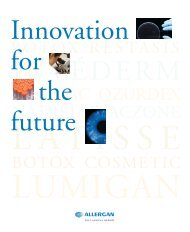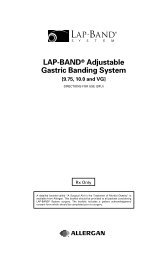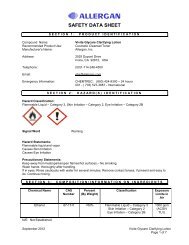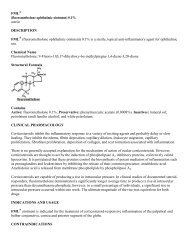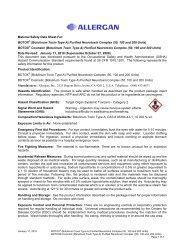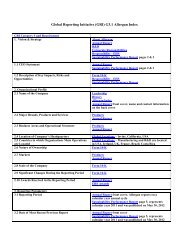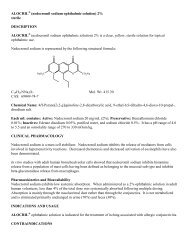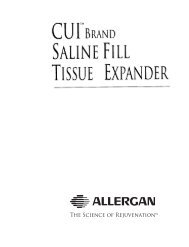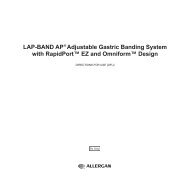OZURDEX® Prescribing Information - Allergan
OZURDEX® Prescribing Information - Allergan
OZURDEX® Prescribing Information - Allergan
- No tags were found...
Create successful ePaper yourself
Turn your PDF publications into a flip-book with our unique Google optimized e-Paper software.
HIGHLIGHTS OF PRESCRIBING INFORMATIONThese highlights do not include all the information needed touse OZURDEX ® safely and effectively. See full prescribinginformation for OZURDEX ® .OZURDEX ® (dexamethasone intravitreal implant)Initial U.S. Approval: 1958_____________ RECENT MAJOR CHANGES_____________ Indications and Usage (1.3) 06/2014_____________ INDICATIONS AND USAGE______________OZURDEX ® is a corticosteroid indicated for: The treatment of macular edema following branch retinalvein occlusion (BRVO) or central retinal vein occlusion(CRVO) (1.1) The treatment of non-infectious uveitis affecting theposterior segment of the eye (1.2) The treatment of diabetic macular edema in patientswho are pseudophakic or are phakic and scheduled forcataract surgery (1.3)__________ DOSAGE AND ADMINISTRATION__________ For ophthalmic intravitreal injection only. (2.1) The intravitreal injection procedure should be carried outunder controlled aseptic conditions. (2.2) Following the intravitreal injection, patients should bemonitored for elevation in intraocular pressure and forendophthalmitis. (2.2)FULL PRESCRIBING INFORMATION: CONTENTS*1 INDICATIONS AND USAGE1.1 Retinal Vein Occlusion1.2 Posterior Segment Uveitis1.3 Diabetic Macular Edema2 DOSAGE AND ADMINISTRATION2.1 General Dosing <strong>Information</strong>2.2 Administration3 DOSAGE FORMS AND STRENGTHS4 CONTRAINDICATIONS4.1 Ocular or Periocular Infections4.2 Advanced Glaucoma4.3 Non-intact Posterior Lens Capsule4.4 Hypersensitivity5 WARNINGS AND PRECAUTIONS5.1 Intravitreal Injection-related Effects5.2 Steroid-related Effects5.3 Risk of Implant Migration_________ DOSAGE FORMS AND STRENGTHS__________Intravitreal implant containing dexamethasone 0.7 mg in theNOVADUR ® solid polymer drug delivery system. (3)_______________ CONTRAINDICATIONS_______________ Ocular or periocular infections (4.1) Advanced glaucoma (4.2) Non-intact posterior lens capsule (4.3) Hypersensitivity (4.4)___________ WARNINGS AND PRECAUTIONS__________Intravitreal injections have been associated withendophthalmitis, eye inflammation, increased intraocularpressure, and retinal detachments. Patients should bemonitored following the injection. (5.1)Use of corticosteroids may produce posterior subcapsularcataracts, increased intraocular pressure, glaucoma, and mayenhance the establishment of secondary ocular infections dueto bacteria, fungi, or viruses. (5.2)The implant may migrate to the anterior chamber if theposterior lens capsule is not intact. (5.3)_______________ ADVERSE REACTIONS_______________In controlled studies, the most common adverse reactionsreported by 20–70% of patients were cataract, increasedintraocular pressure and conjunctival hemorrhage. (6.1)To report SUSPECTED ADVERSE REACTIONS, contact<strong>Allergan</strong> at 1-800-433-8871 or FDA at 1-800-FDA-1088 orwww.fda.gov/medwatch.See 17 for PATIENT COUNSELING INFORMATION.Revised: 06/20146 ADVERSE REACTIONS6.1 Clinical Studies Experience6.2 Postmarketing Experience8 USE IN SPECIFIC POPULATIONS8.1 Pregnancy8.3 Nursing Mothers8.4 Pediatric Use8.5 Geriatric Use11 DESCRIPTION12 CLINICAL PHARMACOLOGY12.1 Mechanism of Action12.3 Pharmacokinetics13 NONCLINICAL TOXICOLOGY13.1 Carcinogenesis, Mutagenesis, Impairment of Fertility14 CLINICAL STUDIES16 HOW SUPPLIED/STORAGE AND HANDLING17 PATIENT COUNSELING INFORMATION* Sections or subsections omitted from the full prescribinginformation are not listed.1
FULL PRESCRIBING INFORMATION1 INDICATIONS AND USAGE1.1 Retinal Vein OcclusionOZURDEX ® (dexamethasone intravitreal implant) is indicated for the treatment of macular edema followingbranch retinal vein occlusion (BRVO) or central retinal vein occlusion (CRVO).1.2 Posterior Segment UveitisOZURDEX ® is indicated for the treatment of non-infectious uveitis affecting the posterior segment of the eye.1.3 Diabetic Macular EdemaOZURDEX ® is indicated for the treatment of diabetic macular edema in patients who are pseudophakic or arephakic and scheduled for cataract surgery.2 DOSAGE AND ADMINISTRATION2.1 General Dosing <strong>Information</strong>For ophthalmic intravitreal injection only.2.2 AdministrationThe intravitreal injection procedure should be carried out under controlled aseptic conditions which include theuse of sterile gloves, a sterile drape, and a sterile eyelid speculum (or equivalent). Adequate anesthesia and abroad-spectrum microbicide applied to the periocular skin, eyelid and ocular surface are recommended to begiven prior to the injection.Remove the foil pouch from the carton and examine for damage. Then, open the foil pouch over a sterile fieldand gently drop the applicator on a sterile tray. Carefully remove the cap from the applicator. Hold theapplicator in one hand and pull the safety tab straight off the applicator. Do not twist or flex the tab. The longaxis of the applicator should be held parallel to the limbus, and the sclera should be engaged at an oblique anglewith the bevel of the needle up (away from the sclera) to create a shelved scleral path. The tip of the needle isadvanced within the sclera for about 1 mm (parallel to the limbus), then re-directed toward the center of the eyeand advanced until penetration of the sclera is completed and the vitreous cavity is entered. The needle shouldnot be advanced past the point where the sleeve touches the conjunctiva.Slowly depress the actuator button until an audible click is noted. Before withdrawing the applicator from theeye, make sure that the actuator button is fully depressed and has locked flush with the applicator surface.Remove the needle in the same direction as used to enter the vitreous.Following the intravitreal injection, patients should be monitored for elevation in intraocular pressure and forendophthalmitis. Monitoring may consist of a check for perfusion of the optic nerve head immediately after theinjection, tonometry within 30 minutes following the injection, and biomicroscopy between two and seven daysfollowing the injection. Patients should be instructed to report any symptoms suggestive of endophthalmitiswithout delay.Each applicator can only be used for the treatment of a single eye. If the contralateral eye requires treatment, anew applicator must be used, and the sterile field, syringe, gloves, drapes, and eyelid speculum should bechanged before OZURDEX ® is administered to the other eye.3 DOSAGE FORMS AND STRENGTHSIntravitreal implant containing dexamethasone 0.7 mg in the NOVADUR ® solid polymer drug delivery system.2
4 CONTRAINDICATIONS4.1 Ocular or Periocular InfectionsOZURDEX ® (dexamethasone intravitreal implant) is contraindicated in patients with active or suspected ocularor periocular infections including most viral diseases of the cornea and conjunctiva, including active epithelialherpes simplex keratitis (dendritic keratitis), vaccinia, varicella, mycobacterial infections, and fungal diseases.4.2 Advanced GlaucomaOZURDEX ® is contraindicated in patients with advanced glaucoma.4.3 Non-intact Posterior Lens CapsuleOZURDEX ® is contraindicated in patients whose posterior lens capsule is not intact.4.4 HypersensitivityOZURDEX ® is contraindicated in patients with known hypersensitivity to any components of this product.5 WARNINGS AND PRECAUTIONS5.1 Intravitreal Injection-related EffectsIntravitreal injections, including those with OZURDEX ® , have been associated with endophthalmitis, eyeinflammation, increased intraocular pressure, and retinal detachments.Patients should be monitored regularly following the injection [see Patient Counseling <strong>Information</strong> (17)].5.2 Steroid-related EffectsUse of corticosteroids including OZURDEX ® may produce posterior subcapsular cataracts, increasedintraocular pressure, and glaucoma. Use of corticosteroids may enhance the establishment of secondary ocularinfections due to bacteria, fungi, or viruses [see Adverse Reactions (6.1)].Corticosteroids should be used cautiously in patients with a history of ocular herpes simplex.5.3 Risk of Implant MigrationPatients in whom the posterior capsule of the lens is absent or has a tear are at risk of implant migration into theanterior chamber.6 ADVERSE REACTIONS6.1 Clinical Studies ExperienceBecause clinical studies are conducted under widely varying conditions, adverse reaction rates observed in theclinical studies of a drug cannot be directly compared to rates in the clinical studies of another drug and may notreflect the rates observed in practice.Adverse reactions associated with ophthalmic steroids including OZURDEX ® include elevated intraocularpressure, which may be associated with optic nerve damage, visual acuity and field defects, posteriorsubcapsular cataract formation, secondary ocular infection from pathogens including herpes simplex, andperforation of the globe where there is thinning of the cornea or sclera.Retinal Vein Occlusion and Posterior Segment UveitisThe following information is based on the combined clinical trial results from 3 initial, randomized, 6-month,sham-controlled studies (2 for retinal vein occlusion and 1 for posterior segment uveitis):3
Table 1: Adverse Reactions Reported by Greater than 2% of PatientsMedDRA Term OZURDEX ®N=497 (%)ShamN=498 (%)Intraocular pressure increased 125 (25%) 10 (2%)Conjunctival hemorrhage 108 (22%) 79 (16%)Eye pain 40 (8%) 26 (5%)Conjunctival hyperemia 33 (7%) 27 (5%)Ocular hypertension 23 (5%) 3 (1%)Cataract 24 (5%) 10 (2%)Vitreous detachment 12 (2%) 8 (2%)Headache 19 (4%) 12 (2%)Increased IOP with OZURDEX ® peaked at approximately week 8. During the initial treatment period, 1%(3/421) of the patients who received OZURDEX ® required surgical procedures for management of elevatedIOP.Following a second injection of OZURDEX ® in cases where a second injection was indicated, the overallincidence of cataracts was higher after 1 year.Diabetic Macular EdemaThe following information is based on the combined clinical trial results from 2 randomized, 3-year, shamcontrolledstudies in patients with diabetic macular edema. Discontinuation rates due to the adverse reactionslisted in Table 2 were 3% in the OZURDEX ® group and 1% in the Sham group. The most common ocular(study eye) and non-ocular adverse reactions are as follows:Table 2: Adverse Reactions Reported by ≥ 1% of PatientsMedDRA Term OZURDEX ®N=324 (%)ShamN=328 (%)OcularCataract 1 166/243 2 (68%) 49/230 (21%)Intraocular pressure increased 3 115 (35%) 16 (5%)Conjunctival hemorrhage 73 (23%) 44 (13%)Visual acuity reduced 28 (9%) 13 (4%)Conjunctivitis 19 (6%) 8 (2%)Vitreous floaters 16 (5%) 6 (2%)Conjunctival edema 15 (5%) 4 (1%)Dry eye 15 (5%) 7 (2%)Vitreous detachment 14 (4%) 8 (2%)Vitreous opacities 11 (3%) 3 (1%)Retinal aneurysm 10 (3%) 5 (2%)Foreign body sensation 7 (2%) 4 (1%)Corneal erosion 7 (2%) 3 (1%)Keratitis 6 (2%) 3 (1%)Anterior Chamber Inflammation 6 (2%) 0 (0%)Retinal tear 5 (2%) 2 (1%)Eyelid ptosis 5 (2%) 2 (1%)Non-ocularHypertension 41 (13%) 21 (6%)4
1 Includes cataract, cataract nuclear, cataract subcapsular, lenticular opacities in patients who were phakic at baseline. Amongthese patients, 61% of OZURDEX ® subjects vs. 8% of sham-controlled subjects underwent cataract surgery.2 243 of the 324 OZURDEX ® subjects were phakic at baseline; 230 of 328 sham-controlled subjects were phakic at baseline.3Includes IOP increased and ocular hypertension.Cataracts and Cataract SurgeryAt baseline, 243 of the 324 OZURDEX ® subjects were phakic; 230 of 328 sham-controlled subjects werephakic. The incidence of cataract development in patients who had a phakic study eye was higher in theOZURDEX ® group (68%) compared with Sham (21%). The median time of cataract being reported as anadverse event was approximately 15 months in the OZURDEX ® group and 12 months in the Sham group.Among these patients, 61% of OZURDEX ® subjects vs. 8% of sham-controlled subjects underwent cataractsurgery, generally between Month 18 and Month 39 (Median Month 21 for OZURDEX ® group and 20 forSham) of the studies.Increased Intraocular PressureTable 3: Summary of Elevated IOP Related Adverse ReactionsTreatment: N (%)IOPOZURDEX ®N=324ShamN=328Any IOP Related AE 120 (37%) 18 (6%)≥10 mm Hg IOP Change from Baseline at any visit 91 (28%) 13 (4%)≥25 mm Hg IOP at any visit 106 (33%) 15 (5%)≥35 mm Hg IOP at any visit 20 (6%) 3 (1%)Glaucoma 4 (1.2%) 1 (0.3%)IOP lowering procedure* 4 (1.2%) 1 (0.3%)* OZURDEX ® : 1 surgical trabeculectomy for steroid-induced IOP increase, 1 surgical trabeculectomy for iris neovascularization,1 laser iridotomy, 1 surgical iridectomySham: 1 laser iridotomyApproximately 42% of the patients who received OZURDEX ® were subsequently treated with IOP loweringmedications during the study. In the sham control group, IOP lowering medications were used in approximately10% of patients.The increase in mean IOP was seen with each treatment cycle, and the mean IOP generally returned to baselinebetween treatment cycles (at the end of the 6 month period) shown below:Figure 1: Mean IOP during the study5
6.2 Postmarketing ExperienceThe following reactions have been identified during post-marketing use of OZURDEX ® in clinical practice.Because they are reported voluntarily from a population of unknown size, estimates of frequency cannot bemade. The reactions, which have been chosen for inclusion due to either their seriousness, frequency ofreporting, possible causal connection to OZURDEX ® , or a combination of these factors, include: complicationof device insertion (implant misplacement), device dislocation with or without corneal edema, endophthalmitis,hypotony of the eye (associated with vitreous leakage due to injection), and retinal detachment.8 USE IN SPECIFIC POPULATIONS8.1 PregnancyPregnancy Category CRisk SummaryThere are no adequate and well-controlled studies with OZURDEX ® in pregnant women. Animal reproductionstudies using topical ocular administration of dexamethasone were conducted in mice and rabbits. Cleft palateand embryofetal death in mice and malformations of the intestines and kidneys in rabbits were observed.OZURDEX ® should be used during pregnancy only if the potential benefit justifies the potential risk to thefetus.Animal DataTopical ocular administration of 0.15% dexamethasone (0.375 mg/kg/day) on gestational days 10 to 13produced embryofetal lethality and a high incidence of cleft palate in mice. A dose of 0.375 mg/kg/day in themouse is approximately 3 times an OZURDEX ® injection in humans (0.7 mg dexamethasone) on a mg/m2basis. In rabbits, topical ocular administration of 0.1% dexamethasone throughout organogenesis (0.13mg/kg/day, on gestational day 6 followed by 0.20 mg/kg/day on gestational days 7-18) produced intestinalanomalies, intestinal aplasia, gastroschisis and hypoplastic kidneys. A dose of 0.13 mg/kg/day in the rabbit isapproximately 4 times an OZURDEX ® injection in humans (0.7 mg dexamethasone) on a mg/m2 basis.8.3 Nursing MothersSystemically administered corticosteroids are present in human milk and can suppress growth and interfere withendogenous corticosteroid production. The systemic concentration of dexamethasone following intravitrealtreatment with OZURDEX ® is low [see Clinical Pharmacology (12.3)]. It is not known whether intravitrealtreatment with OZURDEX ® could result in sufficient systemic absorption to produce detectable quantities inhuman milk. Exercise caution when OZURDEX ® is administered to a nursing woman.8.4 Pediatric UseSafety and effectiveness of OZURDEX ® in pediatric patients have not been established.8.5 Geriatric UseNo overall differences in safety or effectiveness have been observed between elderly and younger patients.11 DESCRIPTIONOZURDEX ® is an intravitreal implant containing 0.7 mg (700 mcg) dexamethasone in the NOVADUR ® solidpolymer sustained-release drug delivery system. OZURDEX ® is preloaded into a single-use, DDS ® applicatorto facilitate injection of the rod-shaped implant directly into the vitreous. The NOVADUR ® system containspoly (D,L-lactide-co-glycolide) PLGA intravitreal polymer matrix without a preservative. The chemical namefor dexamethasone is Pregna-1,4-diene-3,20-dione, 9-fluoro-11,17,21-trihydroxy-16-methyl-, (11β,16α)-. Itsstructural formula is:6
MW 392.47; molecular formula: C 22 H 29 FO 5Dexamethasone occurs as a white to cream-colored crystalline powder having not more than a slight odor, andis practically insoluble in water and very soluble in alcohol.The PLGA matrix slowly degrades to lactic acid and glycolic acid.12 CLINICAL PHARMACOLOGY12.1 Mechanism of ActionDexamethasone, a corticosteroid, has been shown to suppress inflammation by inhibiting multiple inflammatorycytokines resulting in decreased edema, fibrin deposition, capillary leakage and migration of inflammatorycells.12.3 PharmacokineticsPlasma concentrations were obtained from 21 patients with macular edema due to branch retinal vein occlusion(BRVO) and central retinal vein occlusion (CRVO), and 21 patients with diabetic macular edema (DME) priorto dosing and at 4 to 5 additional post-dose timepoints on Days 1, 7, 21, 30, 45, 60, and 90 following theadministration of the first intravitreal implant containing 0.7 mg dexamethasone. In RVO and DME patients,the majority of plasma dexamethasone concentrations were below the lower limit of quantitation (LLOQ = 50pg/mL). Plasma dexamethasone concentrations from 12% of samples were above the LLOQ, ranging from52 pg/mL to 102 pg/mL. Plasma dexamethasone concentration did not appear to be related to age, body weight,or sex of patients.In an in vitro metabolism study, following the incubation of [ 14 C]-dexamethasone with human cornea, irisciliarybody, choroid, retina, vitreous humor, and sclera tissues for 18 hours, no metabolites were observed.13 NONCLINICAL TOXICOLOGY13.1 Carcinogenesis, Mutagenesis, Impairment of FertilityNo adequate studies in animals have been conducted to determine whether OZURDEX ® (dexamethasoneintravitreal implant) has the potential for carcinogenesis.Although no adequate studies have been conducted to determine the mutagenic potential of OZURDEX ® ,dexamethasone has been shown to have no mutagenic effects in bacterial and mammalian cells in vitro or in thein vivo mouse micronucleus test.Adequate fertility studies have not been conducted in animals.14 CLINICAL STUDIESRetinal Vein OcclusionThe efficacy of OZURDEX ® for the treatment of macular edema following branch retinal vein occlusion(BRVO) or central retinal vein occlusion (CRVO) was assessed in two, multicenter, double-masked,randomized, parallel studies.7
Following a single injection, OZURDEX ® demonstrated the following clinical results for the percent ofpatients with ≥ 15 letters of improvement from baseline in best-corrected visual acuity (BCVA):Table 4: Number (Percent) of Patients with ≥ 15 Letters Improvement from Baseline in BCVAStudy 1 Study 2Study DayOZURDEX ®N=201ShamN=202 p-value*OZURDEX ®N=226ShamN=224 p-value*Day 30 40 (20%) 15 (7%) < 0.01 51 (23%) 17 (8%) < 0.01Day 60 58 (29%) 21 (10%) < 0.01 67 (30%) 27 (12%) < 0.01Day 90 45 (22%) 25 (12%) < 0.01 48 (21%) 31 (14%) 0.039Day 180 39 (19%) 37 (18%) 0.780 53 (24%) 38 (17%) 0.087*P-values were based on the Pearson’s chi-square test.In each individual study and in a pooled analysis, time to achieve ≥ 15 letters (3-line) improvement in BCVAcumulative response rate curves were significantly faster with OZURDEX ® compared to sham (p < 0.01), withOZURDEX ® treated patients achieving a 3-line improvement in BCVA earlier than sham-treated patients.The onset of a ≥ 15 letter (3-line) improvement in BCVA with OZURDEX ® occurs within the first two monthsafter implantation in approximately 20-30% of subjects. The duration of effect persists approximately one tothree months after onset of this effect.Posterior Segment UveitisThe efficacy of OZURDEX ® was assessed in a single, multicenter, masked, randomized study of 153 patientswith non-infectious uveitis affecting the posterior segment of the eye.After a single injection, the percent of patients reaching a vitreous haze score of 0 (where a score of 0 representsno inflammation) was statistically significantly greater for patients receiving OZURDEX ® versus sham at week8 (primary time point) (47% versus 12%). The percent of patients achieving a 3-line improvement from baselineBCVA was 43% for patients receiving OZURDEX ® versus 7% for sham at week 8.Diabetic Macular EdemaThe efficacy of OZURDEX ® for the treatment of diabetic macular edema was assessed in two, multicenter,masked, randomized, sham-controlled studies. Subjects were to be evaluated for retreatment eligibility everythree months starting from Month 6 but could only receive successive treatments at least 6 months apart.Retreatment was based on physician’s discretion after examination including Optical Coherence Tomography.Patients in the OZURDEX ® arm received an average of 4 treatments during the 36 months.The primary endpoint was the proportion of patients with 15 or more letters improvement in BCVA frombaseline at Month 39 or final visit for subjects who exited the study at or prior to Month 36. The Month 39extension was included to accommodate the evaluation of safety and efficacy outcomes for subjects whoreceived re-treatment at Month 36. Only fourteen percent of the study patients completed the Month 39 visit(16.8% from OZURDEX ® and 12.2% from Sham).8
Table 5: Visual Acuity outcomes at Month 39 (All randomized subjects with LOCF c )Study Outcomes OZURDEX ® Sham Estimated Difference(95% CI)1 a Loss of ≥15 letters in BCVA (n(%)) 15 (9%) 17 (10%) -1.1% (-7.5%, 5.3%)Gain of ≥15 letters in BCVA (n(%)) 34 (21%) 19 (12%) 9.3% (1.4%, 17.3%)Mean change in BCVA (SD) 4.1 (13.9) 0.9 (11.9) 3.2 (0.4, 5.9)2 b Loss of ≥15 letters in BCVA (n(%)) 30 (18%) 18 (11%) 7.1% (-0.5%, 14.7%)Gain of ≥15 letters in BCVA (n(%)) 30 (18%) 16 (10%) 8.4% (0.9%, 15.8%)Mean change in BCVA (SD) 0.4 (17.5) 0.8 (13.6) -0.7 (-4.1, 2.6)a Study 1: OZURDEX ® , N=163; Sham, N=165b Study 2: OZURDEX ® , N=165; Sham, N=163c 14% (16.8% from OZURDEX ® and 12.2% from Sham) of patients had BCVA outcome at Month 39, for the remaining patients, thedata at Month 36 or earlier was carried forward.Visual acuity outcomes by lens status (Phakic or Pseudophakic) at different visits are presented in Figure 2and Figure 3. The occurrence of cataracts impacted visual acuity during the study. The visual acuityimprovement from baseline increases during a treatment cycle, peaks at approximately 3 Months posttreatmentand diminishes thereafter. Patients who were pseudophakic at baseline achieved greater mean BCVA changefrom baseline at the final study visit.Figure 2 Proportion of Subjects with ≥ 15 Letters Improvement from Baseline BCVA in the Study Eye9
Figure 3 Mean BCVA Change from BaselineThe best corrected visual acuity outcomes for the Pseudophakic and Phakic subgroups from Studies 1 and 2 atMonth 39 are presented in Table 6.Table 6: Visual Acuity outcomes at Month 39 (Subgroup for pooled data with LOCF c )Subgroup(Pooled)Outcomes OZURDEX ® Sham Estimated Difference(95% CI)a PseudophakicGain of ≥15 letters in BCVA(n(%))16 (20%) 11 (11%) 8.4%(-2.2%, 19.0%)Loss of ≥15 letters in BCVA 4 (5%) 7 (7%) -2.2% (-9.1%, 4.7%)(n(%))Mean change in BCVA (SD) 5.8 (11.6) 1.4 (12.3) 4.2 (0.8, 7.6)Gain of ≥15 letters in BCVA 48 (20%) 24 (11%) 9.0% (2.7%, 15.4%)b Phakic (n(%))Loss of ≥15 letters in BCVA 41 (17%) 28 (12%) 4.4% (-1.9%, 10.7%)(n(%))Mean change in BCVA (SD) 1.0 (16.9) 0.6 (12.9) 0.3 (-2.4, 3.0)a Pseudophakic: OZURDEX ® , N=82; Sham, N=99b Phakic: OZURDEX ® , N=246; Sham, N=229c 14% (16.8% from OZURDEX ® and 12.2% from Sham ) of patients had BCVA outcome at Month 39, for the remaining patients thedata at Month 36 or earlier was used in the analysis.10
16 HOW SUPPLIED/STORAGE AND HANDLINGOZURDEX ® (dexamethasone intravitreal implant) 0.7 mg is supplied in a foil pouch with 1 single-use plasticapplicator, NDC 0023-3348-07.Storage: Store at 15 o -30 o C (59 o -86 o F).17 PATIENT COUNSELING INFORMATIONSteroid-related EffectsAdvise patients that a cataract may occur after repeated treatment with OZURDEX ® . If this occurs, advisepatients that their vision will decrease, and they will need an operation to remove the cataract and restore theirvision.Advise patients that they may develop increased intraocular pressure with OZURDEX ® treatment, andthe increased IOP will need to be managed with eye drops, and, rarely, with surgery.Intravitreal Injection-related EffectsAdvise patients that in the days following intravitreal injection of OZURDEX ® , patients are at risk for potentialcomplications including in particular, but not limited to, the development of endophthalmitis or elevatedintraocular pressure.When to Seek Physician AdviceAdvise patients that if the eye becomes red, sensitive to light, painful, or develops a change in vision, theyshould seek immediate care from an ophthalmologist.Driving and Using MachinesInform patients that they may experience temporary visual blurring after receiving an intravitreal injection.Advise patients not to drive or use machines until this has been resolved.© 2014 <strong>Allergan</strong>, Inc.Irvine, CA 92612, U.S.A.® marks owned by <strong>Allergan</strong>, Inc.Patented. See: www.allergan.com/products/patent_noticesMade in Ireland72212US1711





